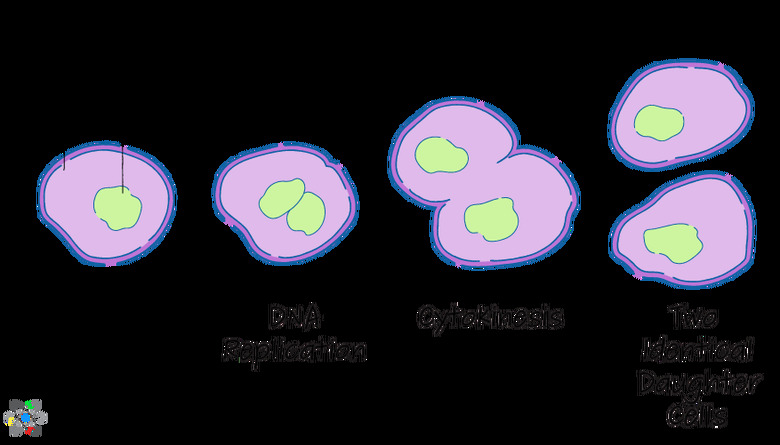Binary Fission: Definition & Process
Unlike the eukaryotic cells found in higher life forms, prokaryotic cells, such as single-cell bacteria, have no nucleus and can't reproduce by duplication of the nucleus' chromosomes.
Instead, they multiply by a process called binary fission, in which the cell simply splits into two. Part of the bacterial survival strategy is to reproduce as quickly as possible when conditions are favorable. When the temperature is right and food is available, binary fission allows for rapid cell growth.
The new cells still have to be the same as the parent cells, so the genetic material has to be identical. This means the the cell's DNA molecules must be duplicated during the binary fission process. Although that adds extra steps, binary fission is still much simpler and faster than eukaryotic cell reproduction and is well-suited to bacteria behavior.
What Is Binary Fission?
What Is Binary Fission?
The process of binary fission is a method of asexual reproduction that results in two identical daughter cells from a single parent cell.
Because it is simpler than the nucleus-based mitosis process of eukaryotic cell division, bacteria can use it to quickly grow in numbers when conditions and resources permit. This fast multiplication is an advantage when competing with other bacteria and other single-cell life forms.
Bacteria simply consume the food that is available, excrete their waste and split when they reach a size that allows them to divide into two viable smaller cells.
What Are the Steps in Binary Fission?
What Are the Steps in Binary Fission?
Although the binary fission process is relatively simple, it still has several steps that have to be completed before new cells are formed.
First the single circular strand of bacterial DNA has to straighten. **DNA replication** of the strand then takes place. At the same time, the cell starts growing into an elongated shape, and the cell membrane then closes between the two new cells near the middle of the elongated parent cell. The detailed steps are as follows:
1. Straightening Out the DNA
The DNA molecule that holds the genetic code for the bacterial cell is a circular strand that is usually tightly coiled. It has to uncoil and straighten so it can be copied.
2. DNA Replication
While the cell is still growing, the enzyme DNA polymerase duplicates the DNA strand. The two copies attach themselves to the cell membrane.
3. Cell Elongation
As the cell grows more, it lengthens by adding cell wall and membrane material around the middle. The two copies of DNA attached to the cell membrane are pulled towards opposite ends of the cell in preparation for final binary fission.
4. Cell Splitting
In binary fission, a parent cell splits into two daughter cells of equal size. Halfway between the elongated cell ends, the cell membrane starts growing into the middle of the cell. Once the membrane has sealed off the two cells, they can separate.
The two new daughter cells now contain a complete set of coiled DNA as well as a share of cell ribosomes and plasmids. They are ready to grow and eventually split themselves
Binary Fission vs. Mitosis
Binary Fission vs. Mitosis
While binary fission is a less complex process than eukaryotic cell division using mitosis, both result in identical daughter cells.
Bacteria use binary fission because that process has certain evolutionary advantages for single-cell organisms. Mitosis is the more controlled process due to its many steps.
Cell division in multicellular organisms can stop if it is not needed, or it can be directed toward forming organs and complex structures. In humans, for example, uncontrolled cell growth can lead to tumors and cancer.
For bacteria, uncontrolled reproduction and growth is an advantage that lets them propagate quickly and compete successfully with other simple organisms.
Cite This Article
MLA
Markgraf, Bert. "Binary Fission: Definition & Process" sciencing.com, https://www.sciencing.com/binary-fission-definition-process-13717680/. 21 May 2019.
APA
Markgraf, Bert. (2019, May 21). Binary Fission: Definition & Process. sciencing.com. Retrieved from https://www.sciencing.com/binary-fission-definition-process-13717680/
Chicago
Markgraf, Bert. Binary Fission: Definition & Process last modified March 24, 2022. https://www.sciencing.com/binary-fission-definition-process-13717680/

